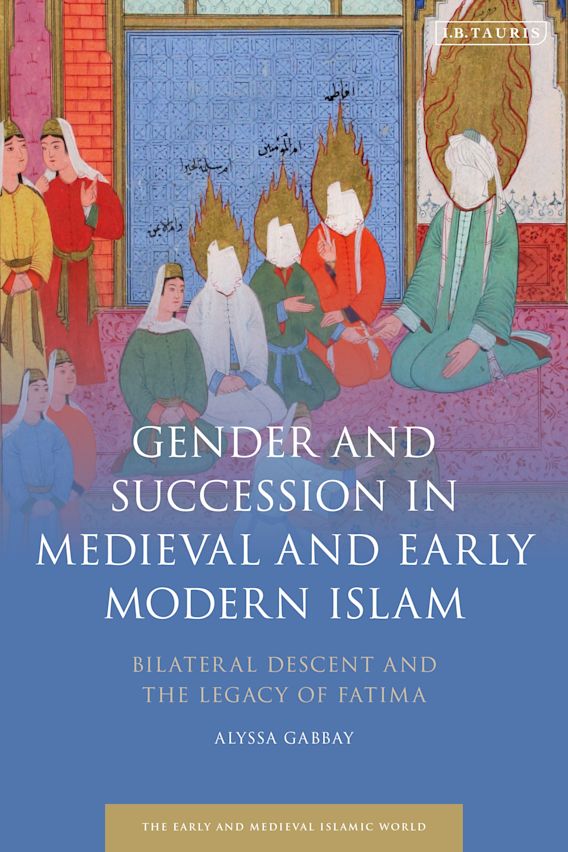by Blake Pye

Rather than use history to make broad statements about the roots of feminism in Islam, Alyssa Gabbay presents a layered and nuanced picture of gender relations in the Islamic past in this work, supported by rigorous research and written in accessible language.
Gender and Succession is Prof. Gabbay’s second monograph following upon Islamic Tolerance (2010). Like that book, this study is a work of synthetic history built upon a central theme, here being the issue of bilateral descent. Bilateral descent is a form of kinship in which inheritance and lineage can be passed down and inherited by both men and women. This is in contrast to patrilineal descent, whereby kinship and lineage are received through the father and sons are given high priority over daughters. Gabbay observes instances of bilateral descent in Islamic history through the lens of Fatima, Muhammad’s daughter and the wife of ‘Ali.
In three parts, which focus on lineage, inheritance, and succession respectively, Gabbay compares the example of Fatima to later potential examples of gender-egalitarianism from pre-modern Islamic civilizations. These parts are supported by a variety of materials, including juridical texts, sayings of Muhammad, chronicles, endowment deeds (waqfiyyat), and more. Rather than detract from the rigor of her work, dealing with diverse textual genres strengthens her study by showing how different kinds of authors grappled with the implications of Fatima’s life and the possibilities for female action in public life.
Each part shows how Fatima’s example pushed against norms that stood in the way of female authority, charisma, and prosperity. The breadth of historical data is quite remarkable for a book that is only 200 pages, but special attention should be given to the way that Gabbay grapples with Fatima’s fiery sermon against those, namely Abu Bakr and ‘Umar, who would rob her of her inheritance from Muhammad. While the provenance of this account may appear dubious being that it was written down centuries after the event, Gabbay centralizes the sermon due to later Shi’i scholars’ (particularly in the Fatimid Caliphate [969-1171]) extensive engagement with Fatima’s purported words. These learned men used the sermon as a jurisprudential precedent to establish women’s right to inherit, leading to a gulf in gender equality between Sunnis and Shi’is. Gabbay adeptly traces the reverberations of the sermon into medieval and early modern history. This same pattern occurs in each part. In the third part on succession, for instance, Fatima’s ambiguous position – an infallible ‘Pure One’ but not an Imam – following the death of the Prophet is mirrored by the few examples in Islamic history in which women took up the mantle of sovereignty when suitable men were absent. Their authority was often challenged, and their accession to power tended to require their casting off of femininity.
Another noteworthy point is that Gabbay seems to have little interest in projecting feminism as an overarching framework for understanding the past; instead, she focuses, to her benefit, on more particular gender-egalitarian social constructions that can exist within largely patriarchal societies. We are thus not led down the treacherous path of justifying patriarchy through a few references to female ascendancy and prosperity. It is not lost on Gabbay, for instance, that Fatima is an exceptional figure in Islamic history; much of her authority stems from the fact that Muhammad had no male heirs. In contrast to the gender egalitarianism that sometimes spawned from Fatima’s precedent, she mentions, citing Denise Spellberg’s study1, how the example of Muhammad’s wife ‘A’isha—sharply criticized by Shi’is and Sunnis alike for her actions at the Battle of the Camel—was also used to justify women’s exclusion from the political sphere.
Gabbay’s study holds together quite well up until the short (only four pages) epilogue. It is not a conclusion which summarizes the book’s findings and explores their implications; instead, it strikes a discordant note by observing a scant few modern examples of female empowerment in Muslim societies. For the vast majority of the book, the author feels no need to establish whether any of her case studies are feminist, yet the questions of what is and what is not feminism and whether feminism is a Western construct come into full focus in the epilogue. Beyond the fact that the epilogue reads like an afterthought, only a couple of the examples she mentions have direct relation to Fatima’s example. In fact, some of these instances of female empowerment are the results of appeals to liberal-democratic institutions (e.g. inheritance and bi-laterality reforms in Morocco and Tunisia). A stimulating alternative to this epilogue might have been a longer conclusion which seriously asks the question of whether Fatima’s example, medieval Shi’i legal scholarship, and instances of female ownership and succession within premodern Islamic societies have retained their valence up to the present day, or whether the struggle for gender equality in majority-Muslim states has become much more of a liberal, democratic, secular, and therefore consciously feminist affair.
Its short epilogue notwithstanding, Gender and Succession is a novel and erudite study which views gender in medieval Islam from the perspective of Fatima’s life and historical influence. Scholars of Islamic studies, those interested in the social dynamics of the pre-modern world, and those interested in the relationship between religion and gender will find much value in Gabbay’s study.
About the Reviewer
Christian Blake Pye is a PhD candidate in Religious Studies. He specializes in the history of medieval and early modern Islam, the Persianate world, Sufism, and Islamic sainthood. His dissertation addresses the development of the Andalusi Sufi theorist of human perfection Ibn ‘Arabi’s philosophy and its political reception as an epistemology which disrupts exclusivist claims to religious truth.
About the Author
Alyssa Gabbay is an Associate Professor of Religious Studies and Director of the Islamic Studies minor at the University of North Carolina, Greensboro. Her research interests include gender and Islam, Shi’ism, pluralism, Indo-Persian culture, and pre-modern Sufism. Her previous book Islamic Tolerance is a study of pluralism in the poetry of Amir Khusraw. Faculty page: (https://rel.uncg.edu/faculty/gabbay/)
